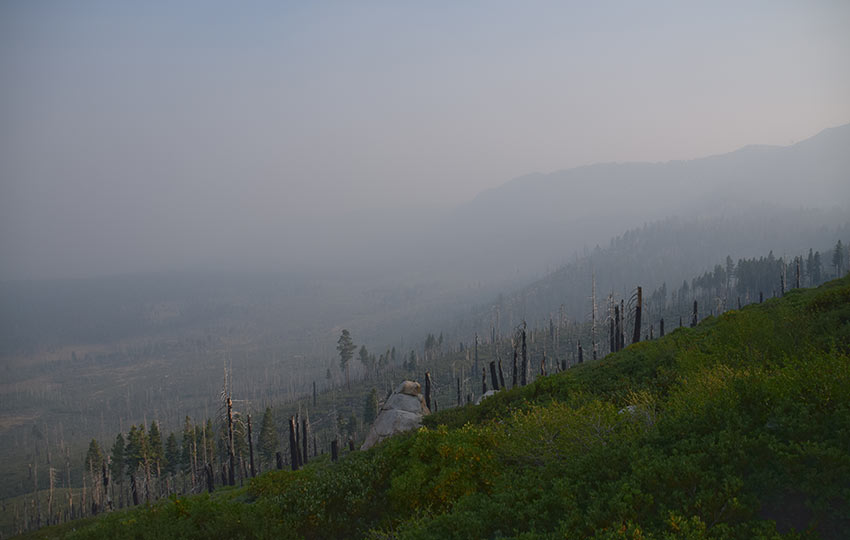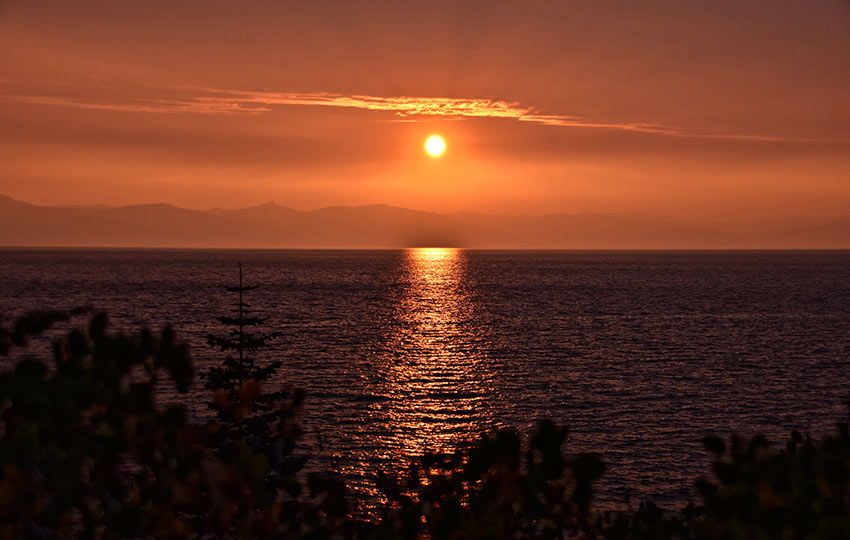
Living at Lake Tahoe and being surrounded by the Sierra Nevada Mountains is like living in a dream. There’s plenty of sunshine in the summer and powdery snow in the winter. The finest outdoor recreation is literally outside your front door.
And, despite the massive influx of visitors that come to Lake Tahoe during the summers and winters and each holiday, the place still maintains its small town vibe.
I moved to Lake Tahoe in 2005 and, ever since, have been learning to live in this dream-like environment. I have to keep reminding myself, though, that with all dreams come the occasional nightmare.
Support Tahoe Trail Guide with a financial contribution via PayPal (single contribution) or Patreon (reoccurring contributions). Your support of Tahoe Trail Guide is very much appreciated!

And Tahoe, like anywhere else in the world, comes equipped with its own set of nightmares with which to contend. For example, all that snow we love to ski and snowboard on during the winter makes for crushing avalanches and hazardous driving conditions. Then, each summer brings the potential threat of wildfire.
In response to the 2018 California wildfires that ravaged the state and the resultant smoke that settled in the Tahoe Basin for weeks, I felt compelled to share what I’ve learned about wildfires and living the mountain experience.
The full article continues after my update about the current status of Lake Tahoe Wildfire & Smoke hazards.
2023 Lake Tahoe Wildfire & Smoke Summary
This section features updates about wildfires and smoke relevant to Lake Tahoe and its neighboring communities.
Believe it or not, the 2023 summer at Lake Tahoe was essentially smoke and wildfire free!
I don’t recommend strenuous outdoor activity when the AQI is over 75. Hiking, running, and biking when it’s that smoky isn’t enjoyable and, depending on your unique circumstances, can lead to health problems.
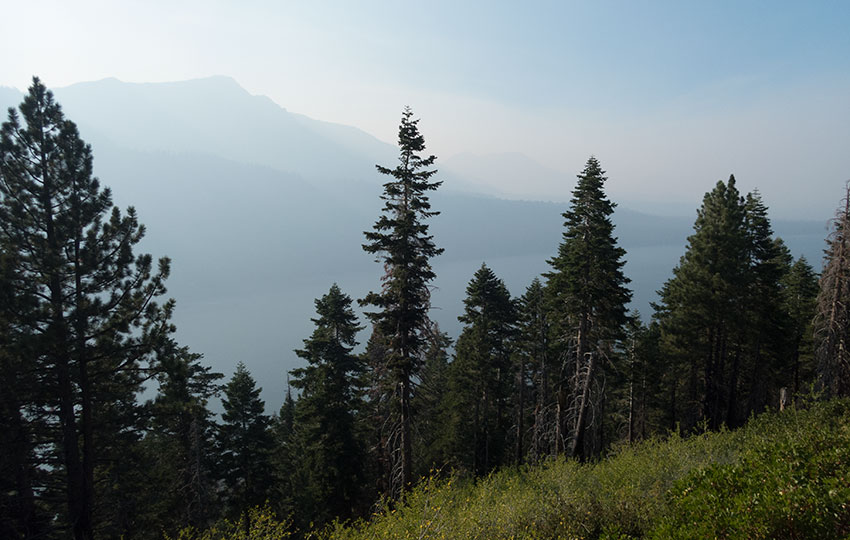
Introduction to Wildfire
Throughout the summer, west coast wildfires become front-page news. Obviously, the people who lose their loved ones and homes suffer the greatest losses. However, wildfires impact everyone in the region.
The air quality is adversely affected (leading to indirect health hazards), and the psychological effects can be significant. It’s hard not to feel like the atmosphere itself – the very air we breathe – conspires to oppress us. The ceiling drops and the world becomes smaller.
With each acre that burns, there’s one less acre for people and wildlife to roam freely. That is, at least until the area recovers. And, due to evacuation measures implemented by the affected municipalities, people gravitate toward the main thoroughfares. This transforms those corridors into a consolidated mass of refugees.
Clearly, this isn’t the summer vacation anyone plans.
Read about post-wildfire forest management at Can We Learn to Handle the Heat of Forest Fires?
California technically is a Mediterranean climate. This means that precipitation falls primarily in the winter. The summers, on the other hand, are often void of any rainfall. So, wildfires in California during the summer are a fact of life. And, believe it or not, they’re necessary for many species to continue surviving.
According to the National Park Service, “As many as 90 percent of wildland fires in the US are caused by humans.” The fact that they occur so easily and with such vigor is evidence that they’re a necessary part of the regional ecosystem.
That said, humans are also a species trying to survive on the west coast. But the only thing wildfires provide for them is the destructive potential to wipe out neighborhoods and displace communities.

My First Experience with California Wildfires
My introduction to wildfires was during the devastating Angora Fire of 2007. This fire occurred in Meyers, CA, just west of South Lake Tahoe. The specific origin location of this fire was the now defunct Seneca Pond in Meyers. In less than a week, 250+ homes were destroyed .
At the time, I was living within South Lake Tahoe’s city limits. So, I didn’t lose my home or have to evacuate like so many of my friends.
No one was officially charged for causing the fire. But, it was determined that an illegal campfire ignited the Angora Fire. Essentially, the people who built the campfire didn’t adequately extinguish it.
Nearly every summer since the Angora Fire, wildfires have brought to Tahoe a few weeks of smoke filled air.
In the summer of 2018, smoke filled the Lake Tahoe Basin from multiple regional California wildfires:
- Ferguson Fire (near Yosemite)
- Carr Fire (near Redding, CA)
- Mendocino Complex Fire (between Redding and Sacramento)
The photos featured on this page illustrate how the smoke settled in South Lake Tahoe in 2018. Keep in mind that these photos, although focused on the 2018 wildfire season at Tahoe, are typical of any summer that wildfire smoke collects in the Tahoe Basin.
Every summer comes with unique variations regarding wildfire smoke in the basin. However, it’s all the same. Smoke floods the Tahoe Basin. Then, the air quality sucks for days on end, and it takes quite awhile for adequate wind to flush the air back out of the basin.
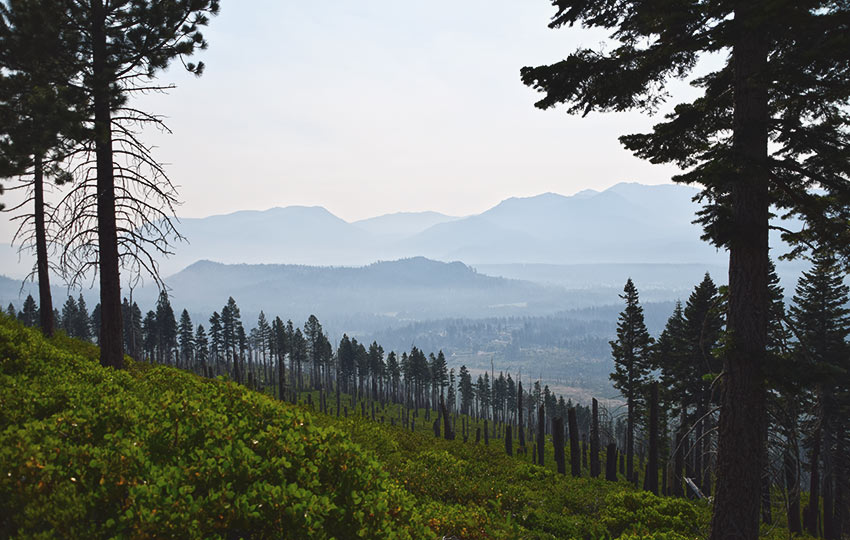
Causes of Wildfires and Tips to Reduce Your Risk of Starting Them
Errant lightning strikes from summer storms are definitely high on the list of ways in which wildfires can ignite. People again, however, are the main problem through actions such as:
- leaving campfires unattended or improperly putting them out
- carelessly tossing aside cigarette butts
- trying to burn their trash instead of simply packing it out
The Voltaire Canyon Fire (just east of Lake Tahoe) in June of 2018 illustrates that last scenario. Two people camping in Voltaire Canyon attempted to “clean up” their campsite by burning their toilet paper and shit.
Needless to say, the fire burned out of their control.
There are numerous other ways in which wildfires can start, and many of them can be random and unpredictable.
For example, the flat tire on a vehicle’s trailer caused the Carr Fire that destroyed over 1,500 structures. Sparks created by the friction between the rim of the flat tire and the asphalt shot into nearby dried vegetation.
Other examples include:
- glass from a broken bottle magnifying the sun’s rays enough to set dry grasses alight
- a vehicle’s hot exhaust pipe making contact with dried vegetation and resulting in ignition.
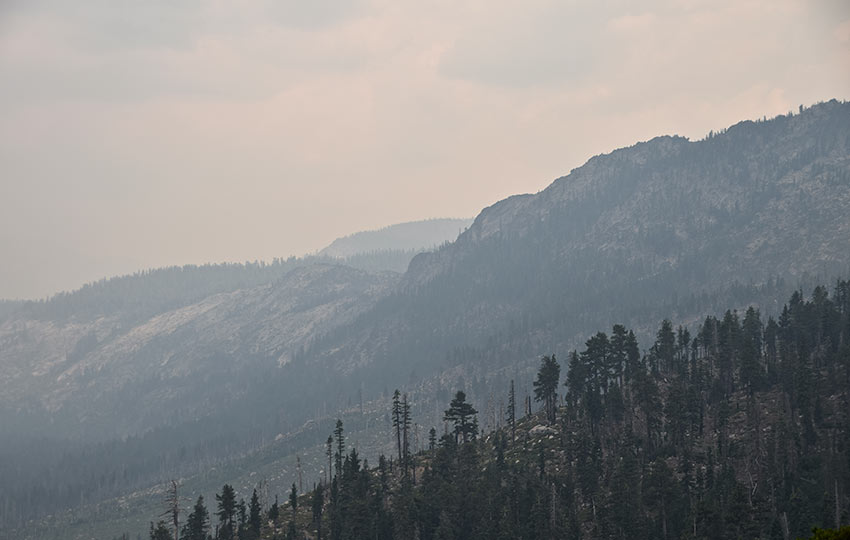
Additional Notes about Wildfires:
Fire can travel along a tree’s root system by smoldering underground for months, and then re-igniting at a later time.
If you think a big snowpack will make everything better for the following summer, think again. The excess snow does help to saturate the land. However, it also enables grasses and opportunistic species to thrive. These species, otherwise, wouldn’t necessarily grow if the soil was drier (i.e. from a normal or lower snowpack level).
Then, those species are quick to dry out when the moisture dissipates. And they ultimately create an even greater fire hazard in the form of abundant ground fuel.
There are so many different ways people can accidentally start wildfires. So it’s up to each individual who travels in the backcountry, sidecountry, and frontcountry to be mindful of their presence. And, they should do everything possible to minimize their impact by embracing the Leave No Trace Seven Principles.
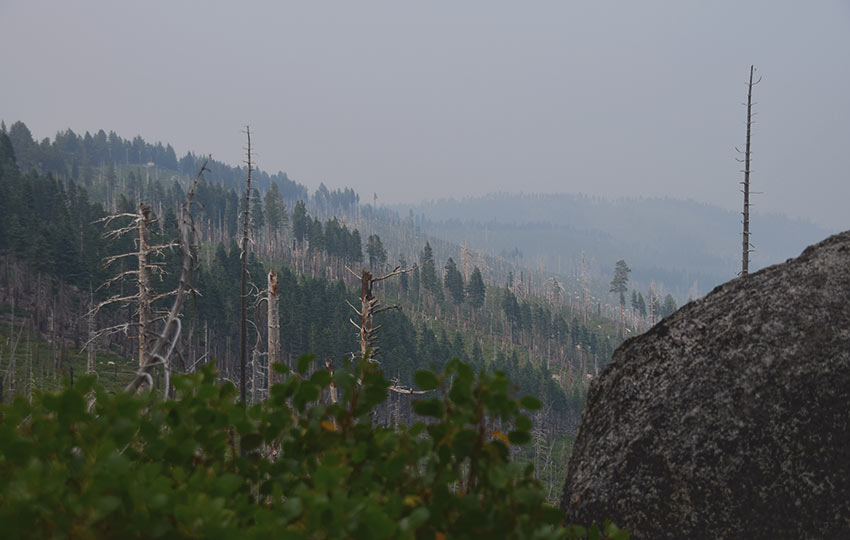
Minimize Your Impact in the Backcountry and Reduce Your Fire Risk
I didn’t even like building campfires at the shelters (with fire rings) back in 1999 when I thru-hiked the Appalachian Trail. It was such a waste of time and energy. Then, you’re breathing in smoke all night while trying to sleep.
I can’t say this enough, but your best bet to avoid causing a wildfire is to simply avoid building campfires altogether. I’ll hammer that one home a few more times before I’m done with this article…
And there are some other considerations to take into account with regards to minimizing your fire risk.
Don’t Build Campfires in the Backcountry
One of the biggest steps toward minimizing your impact in the backcountry, as well as dramatically decreasing your risk of starting a wildfire is to stop having campfires.
Let me repeat – if you truly love and care for wildlands stop building campfires.
To many this is blasphemous, I know. However, artificially introducing fire into the backcountry is as risky and insane an act as any. Unless you’re standing at death’s door, there are no legitimate reasons to have a campfire in the backcountry.
Resist all peer pressure.
Resist all of your learned habits that camping = campfires.
This way of thinking is outdated and not commensurate with the world in which we currently live.
Don’t build a campfire. Don’t do it. Period.
Again, Don’t Build Campfires in the Backcountry!
But what about all of those beautiful moody and nostalgia-inducing photos I see on Instagram of people sitting by their campfire on a granite ledge, next to an alpine lake, or at the beach?
I agree that those photos look beautiful. But when you stop to think about it for half a second, you’ll realize that the majority of those fires captured in frame were built from scratch. This means that they were either illegal or, at least unethical, campfires.
And, after the photographer leaves the site having gained 1,000 more followers for their IG account and 10,000 more “likes” on their photo, they leave in their wake scorched earth.
Have you ever tried to completely erase the evidence of a fire? Impossible.
So what you leave behind is a blight on Mother Earth for everyone else to enjoy.
Oh, and you’re not doing anyone a favor by leaving that brand new fire ring intact. All you’re going to succeed at is increasing the odds of burning to ash the area you claim to love.
By introducing the idea (i.e. through social media) of building campfires in remote terrain you normalize the behavior so that people no longer view building a campfire as a risky endeavor (which it is, always!). They are then more likely to copy the act, thereby increasing the overall risk for starting a wildfire.
What’s the alternative to building a campfire, then?
Wear warmer clothes and enjoy being a part of nature — not apart from nature.
Campfires…
- attract moths but repel just about every other critter out there
- diminish the view of the stars overhead
- encourage you to stay awake far longer than you would if you were camping without one — then you sleep in late and miss the following morning’s sunrise
Going to sleep and waking up with the sun is one of the primary reasons I love to backpack. This experience evokes a sense of connection with the natural rhythm of the day.
Don’t Smoke in the Backcountry
You’d be surprised at how many long-distance thru-hikers (i.e. Appalachian Trail, Pacific Crest Trail) are also smokers. I’ve never understood it but … whatever.
The bottom line is that if you do smoke in the backcountry, stop moving. Stop hiking and stop wandering around while you’re actually smoking. Hang out and enjoy the scenery for that short while. But then field strip that cigarette butt and dispose of the filter properly (i.e. pack it out).
The problem with walking and smoking is that you run the risk of depositing embers along the way.
Don’t Burn Your Trash in the Backcountry
Hobos from the 1940s called and they want their beliefs back. If you have at least a sixth grade education, you shouldn’t even be humoring the thought of burning your trash.
Burning your trash instead of leaving behind a pile of trash just means you’re leaving behind a pile of burnt trash. Get with the program and pack out all of your trash. And, that includes toilet paper.
The easiest way to pack out your trash is to not bring excessive packaging in the first place. Before leaving the house (or store), field strip all of your food stuff. Basically, dispose of (properly) the extra packaging before reaching the trailhead. This minimizes the amount of packaging on-hand. Then, you can just collect everything you plan to dispose of in a Ziploc bag.
On a backpacking trip lasting 3-7 days, I never come close to filling a gallon Ziploc with trash.
Inspect and Properly Maintain Your Vehicle
Sometimes access to the trailhead requires you to drive on undeveloped roads through the backcountry. This is fun stuff!
However, the experience can turn into a nightmare if your vehicle…
- overheats
- has an electrical issue and catches fire
- breaks due to physical stresses placed on the suspension
Often along backcountry roads you’ll be operating at slower speeds for longer periods of time while negotiating variable terrain. This places excessive stress on your vehicle’s engine. How? By causing it to run at a higher temperature for a sustained period of time.
Make sure the engine oil and coolant are full and look clean. Be mindful of your vehicle, especially if its engine and undercarriage are coated with various fluids. Excessive fluid should compel you to have your vehicle checked out for leaks no matter where you plan to drive. However, it’s especially important to address if you’re going to be driving under backcountry conditions. These leaking fluids can catch fire due to…
- a hot engine
- sparks from electrical issues under the hood
- sparks caused by friction between the metal of your vehicle and rocks
Always carry in your vehicle a fire extinguisher. And, have it readily available when driving along backcountry roads.
Also, everything on/in your vehicle will bounce around more when driving on backcountry roads compared to a paved road. Your suspension system will be under a lot of strain as a result. Objects within the cab of your vehicle might fly around (and hit you or break a window). And delicate parts such as wiring could move and make contact with other parts of the vehicle.
Last Thoughts about Wildfires
Regardless of where you live, determine the local forecast and weather conditions for your planned destination. This way you’ll be more prepared to time your adventure appropriately (i.e. between storms).
If you’re visiting Lake Tahoe, the following short list features websites that provide relevant information about current conditions:
- Tahoe Daily Tribune (print and online newspaper)
- South Tahoe Now (online news and events source)
- Tahoe South (South Lake Tahoe’s Visitor Authority website)
- Tahoe Weekly (print and online news and events source)
- Lake Tahoe Basin Management Unit (Forest Service division that manages lands in the Lake Tahoe Basin)
- YubaNet (online news source that features fire conditions)
- Sierra Avalanche Center (winter related snow conditions)
- OpenSnow (winter related snow conditions)
- National Weather Service (NOAA – use the specific Tahoe location in which you’ll be traveling for the most accurate forecast)
As much as I complain about the smoke, I know it’s only an inconvenience for me. Wildfire smoke, in and of itself, isn’t a life-changing event like actually losing a home or a loved one.
That said, modify your activities when recreating in an area where smoke has accumulated due to wildfires.
And, governing bodies can implement and enforce laws. Ultimately, however, the individual is the only entity who will prove to be the best (or worst) steward of wildlands.
Like Smokey says, “Only you can prevent forest fires.”
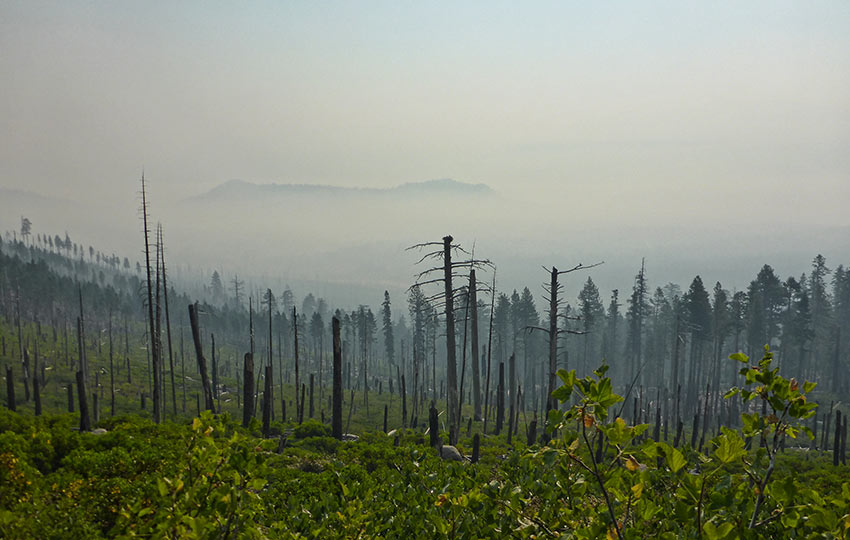
Please note that many of the following news links may not still be active/accurate. For whatever reason, it seems like most news websites do a terrible job of maintaining archived stories/links.
2022 Lake Tahoe Wildfire & Smoke Summary
This section features updates about wildfires and smoke relevant to Lake Tahoe and its neighboring communities.
- Rains during September 18-21, 2022, cleared the Tahoe/Truckee region of wildfire smoke from the Mosquito Fire, and helped to slow down the fire’s advance toward the west.
- Smoke from the Mosquito Fire, west of Lake Tahoe (Foresthill), entered the Basin on the evening of September 7, 2022. Wildfire smoke was concentrated on the west and south shore of Lake Tahoe with an approximate AQI of 175 on September 8, 2022.
- Illegal campers at Emerald Point allowed their illegal campfire to get out of control and cause a quarter acre of damage on August 12, 2022.
- The AQI was approximately 250 on July 24, 2022, due to smoke from the Oak Fire (Yosemite) entering the Tahoe Basin. However, the air at Lake Tahoe cleared within about a week or so.
- Smoke from the Washburn Fire (Yosemite) entered the Lake Tahoe Basin on July 10, 2022, and lingered for a couple of days. The air quality was ok for outdoor activity, but the smoke was obvious (smell/see).
- Arsonist sets spot fires near Truckee leading to evacuations on July 7, 2022.
- Electra Fire in Amador County ignites (possibly due to illegal fireworks) on July 4, 2022. Minimal wildfire smoke enters Lake Tahoe Basin on July 5, but doesn’t last long as firefighters begin to contain the fire.
- Vegetation fire in Genoa (near Carson City) is quickly contained on June 17, 2022.
2021 Lake Tahoe Wildfire & Smoke Summary
Wildfire smoke from the Tamarack Fire in Alpine County (Markleeville, CA) filled the Lake Tahoe Basin on the afternoon of July 18, 2021. The Tamarack Fire originated on July 4, 2021, from a lightening strike. At the time, the Forest Service noted the location of the lightning strike and determined that it posed no immediate threat. Unfortunately, due to the drought conditions brought on by the previous low-snow winter (2020-21) and high winds that manifested over the days following July 4th, the Tamarack Fire took hold and increased exponentially. Smoke from the Dixie Fire (Chico, CA) also entered the Tahoe Basin on July 24, 2021.
Between the two fires (Tamarack and Dixie) and a series of small thundershowers (between July 24-30), wildfire smoke came and went with some frequency. Then, on August 6, 2021, winds changed overnight and smoke from the Dixie Fire flooded the Tahoe Basin.
The next wildfire to affect the Lake Tahoe Basin was the Caldor Fire, on August 17, 2021. The fire began on August 14th, but smoke didn’t arrive in the basin until the morning of August 17th. The smoke came and went for a few days following its arrival. However, the smoke is persistent everyday, frequently reaching high AQIs of 600+.
The Caldor fire reached Echo Summit on August 29, and entered the Lake Tahoe Basin on August 30th. I was evacuated from my home in Meyers (very close to Echo Summit) on August 29 (until September 11), as well as residents of Christmas Valley. Residents of South Lake Tahoe and Stateline were evacuated in the following days (most of them on August 30). Many of those residents from the Nevada side of Tahoe and those who live in the city limits of South Lake Tahoe were able to start repopulating by September 5. I wasn’t able to go home until September 11. And, Christmas Valley residents were allowed to go back on September 12.
As of October 14, the Caldor Fire was at 98% containment and air quality is good, but Forest Service lands on the south shore are closed to the public until December 31, 2021.
Backcountry and Trail Closures (notices) at Lake Tahoe due to Wildfire Threat
- Caldor Fire is at 98% containment (10/9/21)
- Lake Tahoe Basin Management Unit Caldor Fire Emergency Closure Order in effect until December 31, 2021 (9/21/21)
- Caldor Fire is at 69% containment (9/14/21)
- South Tahoe was completely evacuated (over 22,000 people at once!) between August 29 – September 12, 2021
- Evacuation orders and warnings are expanding due to the Caldor Fire (8/20/21)
- HWY 50 from Sly Park to Meyers is closed (8/20/21)
- All CA State Parks on the west shore of Lake Tahoe are closed to the public (8/20/21)
- All Forest Service lands in the Lake Tahoe Basin are closed to the public (8/20/21)
- Significant portions of hiking along the west shore of Lake Tahoe are closed for recreational use (8/19/21)
- El Dorado National Forest is closed to all recreational use, possibly through September (8/18/21)
- 48-hour red flag warning for Lake Tahoe meaning that the use of all ignition sources, including the gas grill on your porch at home, are prohibited (July 18, 2021)
- Road closures south of South Lake Tahoe/Meyers on SR 88, 89, and 4 (July 17, 2021)
2020 Lake Tahoe Wildfire & Smoke Summary
On August 17, 2020, wildfire smoke from the Loyalton Fire (near Reno, NV) filled the Lake Tahoe Basin. After that, smoke from other regional wildfires blew into the Lake Tahoe Basin causing persistently poor air quality for over a month. Tahoe experienced periodic breaks from the smoke during that time, but they were few and far apart. Light rains fell on September 18th leading to better air quality, but the AQI jumped back up to 130 on September 21st. The air cleared between September 23-28. It elevated again from September 29th – October 7th, and then finally cleared up for the season by October 8th.
- All forests, campgrounds, and day-use recreation sites at Lake Tahoe are shut down and off-limits due to the threat of wildfire (September 7, 2020).
- Red flag warning for Lake Tahoe meaning the use of all ignition sources (even the gas grill on your porch at home) are prohibited (September 8, 2020).
- All National Forests in California are temporarily closed, including all the US Forest Service Land in the Lake Tahoe Basin (September 9, 2020).
- Trails, day-use areas, and recreation sites are back open on Forest Service Land at Lake Tahoe, but overnight camping in the Tahoe Basin is prohibited until November 30, 2020 (September 19, 2020).
